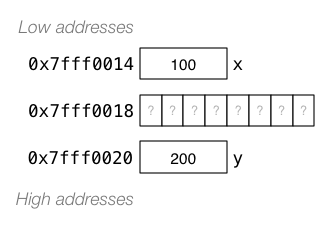Week 03 Tutorial Questions
-
On a machine with 16-bit
ints, the C expression(30000 + 30000)yields a negative result.Why the negative result? How can you make it produce the correct result?
-
Assume that the following hexadecimal values are 16-bit twos-complement. Convert each to the corresponding decimal value.
0x00130x04440x12340xffff0x8000
-
Give a representation for each of the following decimal values in 16-bit twos-complement bit-strings. Show the value in binary, octal and hexadecimal.
- 1
- 100
- 1000
- 10000
- 100000
- -5
- -100
-
What decimal numbers do the following single-precision IEEE 754-encoded bit-strings represent?
0 00000000 000000000000000000000001 00000000 000000000000000000000000 01111111 100000000000000000000000 01111110 000000000000000000000000 01111110 111111111111111111111110 10000000 011000000000000000000000 10010100 100000000000000000000000 01101110 10100000101000001010000
Each of the above is a single 32-bit bit-string, but partitioned to show the sign, exponent and fraction parts.
-
Convert the following decimal numbers into IEEE 754-encoded bit-strings:
- 2.5
- 0.375
- 27.0
- 100.0
-
Write a C function,
six_middle_bits, which, given auint32_t, extracts and returns the middle six bits. -
Draw diagrams to show the difference between the following two data structures:
struct { int a; float b; } x1; union { int a; float b; } x2;
If
x1was located at&x1 == 0x1000andx2was located at&x2 == 0x2000, what would be the values of&x1.a,&x1.b,&x2.a, and&x2.b? -
How large (#bytes) is each of the following C
unions?-
union { int a; int b; } u1;
-
union { unsigned short a; char b; } u2;
-
union { int a; char b[12]; } u3;
-
union { int a; char b[14]; } u4;
-
union { unsigned int a; int b; struct { int x; int y; } c; } u5;
You may assume
sizeof(char)== 1,sizeof(short)== 2,sizeof(int)== 4. -
-
Consider the following C
unionunion _all { int ival; char cval; char sval[4]; float fval; unsigned int uval; };
If we define a variable
union _all var;and assign the following valuevar.uval = 0x00313233;, then what will each of the following printf(3)s produce:-
printf("%x\n", var.uval); -
printf("%d\n", var.ival); -
printf("%c\n", var.cval); -
printf("%s\n", var.sval); -
printf("%f\n", var.fval); -
printf("%e\n", var.fval);
You can assume that bytes are arranged from right-to-left in increasing address order.
-
-
Consider the following small C program:
int a; // global int variable int main (void) { int b; // local int variable char c; // local char variable char d[10]; // local char array ... } int e; // global? int variable int f (int g) // function + parameter { double h; // local double variable double *j; // pointer to double object ... j = malloc (sizeof (double)); ... }
Describe the following properties for each of the objects
a,b, ...j, and*j- region (which part of the memory is the object located in)
- size (how large is the object, in bytes)
- scope (which part of the program can
see
the object) - lifetime (when is the object created, and when removed)
-
Consider the following generic code which sets the value of a pointer (to a hopefully legal address on the stack), and subsequently increments it:
Type *ptr = 0x7ffff000; ... ptr = ptr + 1; // what value does ptr have here?For each of the following variants of
Type, show what the value ofptrwould be after it is incremented:intshort intchardoublestruct xyz { int x; int y; int z; }struct abc { char a; int b; float c; }
Make explicit assumptions about the sizes of various types.
-
Consider the following C program fragment:
int main (void) { int x = 100; char s[8]; int y = 200; ... strcpy (s, "a long name"); ... }
If the memory looks like

at the start of the program, show what it looks like after the strcpy(3) is executed.
-
Without using any index variables in your function, implement a function
myStrCmp(a,b)which behaves like the standardstrcmp(a,b)function:-
if
aappears beforebin the dictionary, return a negative value -
if
aappears afterbin the dictionary, return a positive value -
if
aandbare the same string return 0
You can assume that both strings are terminated by a
'\0'character. Make sure you handle the case where the strings are different lengths, and one string is a sub-string of the other.Use the following function prototype:
int myStrCmp (char *a, char *b);
-
if